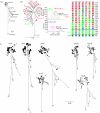Mismatch induced speciation in Salmonella: model and data
- PMID: 17062419
- PMCID: PMC1764929
- DOI: 10.1098/rstb.2006.1925
Mismatch induced speciation in Salmonella: model and data
Abstract
In bacteria, DNA sequence mismatches act as a barrier to recombination between distantly related organisms and can potentially promote the cohesion of species. We have performed computer simulations which show that the homology dependence of recombination can cause de novo speciation in a neutrally evolving population once a critical population size has been exceeded. Our model can explain the patterns of divergence and genetic exchange observed in the genus Salmonella, without invoking either natural selection or geographical population subdivision. If this model was validated, based on extensive sequence data, it would imply that the named subspecies of Salmonella enterica correspond to good biological species, making species boundaries objective. However, multilocus sequence typing data, analysed using several conventional tools, provide a misleading impression of relationships within S. enterica subspecies enterica and do not provide the resolution to establish whether new species are presently being formed.
Figures



Similar articles
-
The speciation and hybridization history of the genus Salmonella.Microb Genom. 2019 Aug;5(8):e000284. doi: 10.1099/mgen.0.000284. Epub 2019 Jul 26. Microb Genom. 2019. PMID: 31347998 Free PMC article.
-
Gene flow and species boundaries of the genus Salmonella.mSystems. 2023 Aug 31;8(4):e0029223. doi: 10.1128/msystems.00292-23. Epub 2023 Jul 24. mSystems. 2023. PMID: 37486130 Free PMC article.
-
Molecular phylogeny of the salmonellae: relationships among Salmonella species and subspecies determined from four housekeeping genes and evidence of lateral gene transfer events.J Bacteriol. 2008 Nov;190(21):7060-7. doi: 10.1128/JB.01552-07. Epub 2008 Aug 29. J Bacteriol. 2008. PMID: 18757540 Free PMC article.
-
A genomic overview of the population structure of Salmonella.PLoS Genet. 2018 Apr 5;14(4):e1007261. doi: 10.1371/journal.pgen.1007261. eCollection 2018 Apr. PLoS Genet. 2018. PMID: 29621240 Free PMC article. Review.
-
A comprehensive review of non-enterica subspecies of Salmonella enterica.Microbiol Res. 2018 Jan;206:60-73. doi: 10.1016/j.micres.2017.09.010. Epub 2017 Oct 7. Microbiol Res. 2018. PMID: 29146261 Review.
Cited by
-
Sequences, sequence clusters and bacterial species.Philos Trans R Soc Lond B Biol Sci. 2006 Nov 29;361(1475):1917-27. doi: 10.1098/rstb.2006.1917. Philos Trans R Soc Lond B Biol Sci. 2006. PMID: 17062411 Free PMC article. Review.
-
Cryptic lineages of the genus Escherichia.Appl Environ Microbiol. 2009 Oct;75(20):6534-44. doi: 10.1128/AEM.01262-09. Epub 2009 Aug 21. Appl Environ Microbiol. 2009. PMID: 19700542 Free PMC article.
-
New analysis for consistency among markers in the study of genetic diversity: development and application to the description of bacterial diversity.BMC Evol Biol. 2007 Sep 3;7:156. doi: 10.1186/1471-2148-7-156. BMC Evol Biol. 2007. PMID: 17767711 Free PMC article.
-
Substructure within Salmonella enterica subsp. enterica isolates from Australian wildlife.Appl Environ Microbiol. 2011 May;77(9):3151-3. doi: 10.1128/AEM.02764-10. Epub 2011 Mar 4. Appl Environ Microbiol. 2011. PMID: 21378038 Free PMC article.
-
The dynamic genetic repertoire of microbial communities.FEMS Microbiol Rev. 2009 Jan;33(1):109-32. doi: 10.1111/j.1574-6976.2008.00144.x. Epub 2008 Nov 24. FEMS Microbiol Rev. 2009. PMID: 19054116 Free PMC article. Review.
References
-
- Beltran P, et al. Toward a population genetic analysis of Salmonella: genetic diversity and relationships among strains of serotypes S. choleraesuis, S. derby, S. dublin, S. enteritidis, S. heidelberg, S. infantis, S. newport, and S. typhimurium. Proc. Natl Acad. Sci. USA. 1988;85:7753–7757. doi:10.1073/pnas.85.20.7753 - DOI - PMC - PubMed
-
- Brown E.W, Mammel M.K, LeClerc J.E, Cebula T.A. Limited boundaries for extensive horizontal gene transfer among Salmonella pathogens. Proc. Natl Acad. Sci. USA. 2003;100:15 676–15 681. doi:10.1073/pnas.2634406100 - DOI - PMC - PubMed
-
- Cohan F.M. Does recombination constrain neutral divergence among bacterial taxa. Evolution. 1995;49:164–175. doi:10.2307/2410302 - DOI - PubMed
Publication types
MeSH terms
Grants and funding
LinkOut - more resources
Full Text Sources

